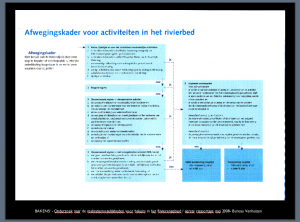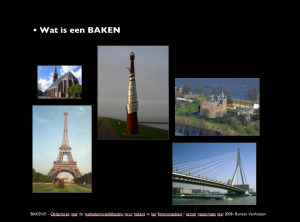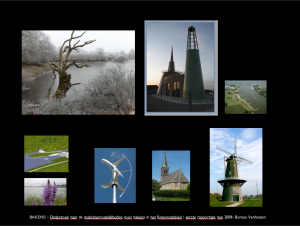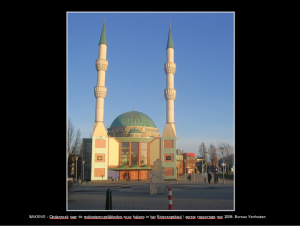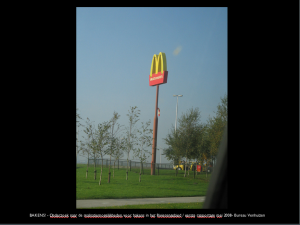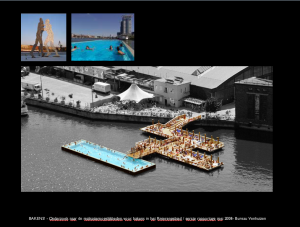Lecture at Stroomhuis at Neerijnen
Lecture at Stroomhuis at Neerijnen
Friday June 27 2008
Two years ago, many governments and other stakeholders in the river area gave a follow up to their concern that the spatial interventions on large-scale in the floodplains the spatial quality, the visibility and uniqueness of the river landscape will be under pressure and they wrote the contest ‘Landmarks at the Waterfront’.
Even as you can see here on the exhibition the contest gave richness about ideas and angles. Typical elements of the river landscape were ‘marked’ by monumental additions or they were just temporary painted. New places were created by the construction of jetties and other special contractions and special events were presented.
The most striking about the winner is that he emanates from existing beacons and, as he calls, it, re-defines it. With careful and subtle additions he awakens existing characteristic elements of the river landscape, such as brickworks, and brings them in a new and contemporary context. So they can be reused both functional as for the legibility of the landscape.
When we look at the occupations of the contributors we see a beautiful range of cultural practitioners. The creator of the winning proposal beacon is not an artist but an architect by profession. The subject of the contest, to give significant provision to the landscape, is something where today a wide range of arts and cultural practitioners are interested in and will step up. A regular discussion is how to manage this in the best way, from which discipline, which approach, form which loyalty but can’t unequivocally been answered.
This ambition is not asking for one generic approach, doesn’t require a unique formula that should be link meaning with cultural landscape. The wide range of approaches and perspectives that is continuously developed, makes it possible for specific situations to make specific designs, allowing more emphasis on determine the contract.
At about 5 months ago I was asked to explore and formulate the realizing potential beacons at the waterfront. And to determine the contract for new beacons. Just a word about myself. I once studied planning in Nijmegen but switched to the Arnhem academy where I studied art in public space. For about ten years, I’m primarily engaged in initiating and organizing projects within the cultural dimension of planning. It contents representing studies of cultural phenomena, organizing contests and participatory processes and art in public space.
The follow-up of Landmarks at the Waterfront actually has three main elements.First, the changes in the river area due to the actions of the measures for the capacity of the river. Second, the results of the competition. And third, what is a landmark. There are several options for those three elements to switch together. So you can take the perspective of the locations to see what is going on and what opportunities are hidden and connect winners and other participants to the possibilities.
The contest itself can be a starting point and to find locations to realize winners and others. Actually my approach combines these two but supports the search to focus the question what a beacon really is. The criteria for a landmark create the opportunity for the achievement in an area where participants have to be included. However, there will been probably opportunities for landmarks where none of the participants has made a proposal. In that case, there will be looked around beyond the results of the competition. I am currently halfway with my command so what can I present today is as an intermediate. My final proposal can be expected in November this year. I want to lead you along on my quest for the future landmarks at the waterfront.
Rijkswaterstaat estimated that at least 100 environmental projects in the area between Nijmegen - Gorinchem are active. Most of the project is dam diversions, other power-enhancing measures and nature development. The project team of Waalweelde shares the assessment and has a good survey of all developments in the river area. Waalweelde is a collaboration of county, municipal and water board, is committed to make the river not only safer, the main aim of Rijkswaterstaat, but above all to make the area more beautiful. In current and upcoming projects are numerous possibilities for landmarks, but it requires a unifying plan. The ultimate definition of a future landmark will allow examining the area more precisely.
And now something about the regulations around the rivers. Until three years ago the authorized providers of Rijkswaterstaat adressed initiatives as landmarks on the waterfront directly to the litter bin. Building in the floodplain was still excluded. Meanwhile the capabilities of the policy regime of rivers is extended. Following is the schedule so you know whether you can build or not. Although there is a wide range of conditions, initiatives in the floodplain are at least in advance not rejected.A brief overview: From dike embankment crest to crest, all initiatives are licensed by Rijkswaterstaat.
The principle is: - the stream should not be built - In and around the cribs it is possible to place building constructions provided that traffic and water flow is not impeded, something that soon will be the case. - In the floodplain are structures possible that do not disturb the water flow. It is true that the higher the site of the proposed landmark the more promising.
But only a permit of Rijkswaterstaat is not sufficient. The Waterschap must also license interventions in and around the dykes. In addition,environmental and soil tests are performed by Public Works and the Ministry of Agriculture with the province’s tests the impact on the flora and fauna to the current policy. The municipality shall review all to the current zoning and should adjust when necessary. The municipality must also provide a building permit and keys one another also to the safety requirements. And all this can obviously only occur when the owner of the land is chord and enough enthusiasm and financial arrangements are settled with the management group, quality team, Province, Wealth and other stakeholders.The realization of beacons is not an easy task but certainly not impossible. That brings me to the question what really a beacon is.
That is no question for the licensing authority of Rijkswaterstaat. Beacons are the green and red signs that indicate where the channel in the river is running right. But the general meaning of the term beacon is now much further than the “mark indicates that indicates the channel”. The concept beacon evades the channel.
The chimneys of the brick factory were typical for the river, especially before the radar era, had the role and significance of the beacons for sailors and visitors to the area. But equally well functioning church towers, bridges, large buildings and obvious landscape situations as beacons for all who travel through the landscape. Not necessarily to indicate a “channel” but to be able to orient themselves, to position themselves pertaining to the familiar object. This is the first and most important criterion of a beacon, it should be a visible and identifiable object in order to provide spatial guidance.
Not only by the Rijkswaterstaat but also according the strollers the area “swarm” of beacons along the Waal. They refer not to the marks that indicate the channel but many visible elements such as windmills, church towers, trees, chimneys, Dijkhuizen, waterfronts, dike curves, locks, outlets, cribs and the like which entice to telling stories on the morning strolls through the floodplains. Behind each story lies a beacon and each story is stored in a beacon. We can infer that there would be no need for new beacons but is not the case. The landscape constantly creates new stories that can be told, who creates beacons and make new meanings in the landscape visible.
The criterion visibility can link to a relatively formal review. Who, from where and how should it be visible. But the concept recognizable has multiple layers. For how should the beacon be identified, in its visibility, materials, function or meaning? Meaning, the city says sociologist Kevin Lynch, has little relevance for the recognition because many space users are attached to very different meanings of the landmarks in the built environment. So you can hear from Christian people that they see Jesus as a beacon in their lives, their grip. But atheists or adherents of other religions will not have those feelings by seeing a picture of Jesus.
But when the image of Jesus on top of a mountain in Rio de Janeiro the entire skyline of the city dominates everyone will like him in his own way considered a beacon, regardless of religious preference. A good beacon can use multiple senses to absorb, simply because of its spatial dominance.
The same goes for church towers that used to be recognized by the remote location as the house of God but nowadays in our less religious society have a more cultural orientation and historical function. To give you an example of a current beacon to indicate that is not connected to the river, I take you to current residence Rotterdam.
The Mevlana Mosque in Rotterdam West serves over again as a beacon in my directions for visitors who have not been subject to a GPS. The mosque is a striking pastel colour building where the references of recognizable historic mosque architecture almost executed on a Disney-like manner. The building was before its handover in 2001 at all the headlines when a piece of concrete minaret by the strong winds was blown of the building. This initial fame was soon overtaken by world history. In fact the mosque was opened shortly after the events of September 11, 2001. Since it appears the Mevlana mosque is a perfect backdrop for the latest news around Muslims, their religion, culture and terrorism. New Teams are regularly filming to observe, the building emerges recently as ‘general illustration’ items in the media, and act in a cut scene supposedly at the public broadcaster. If we analyze the current situation surrounding this prominent landmark in the city of Rotterdam, we uncover a number of phenomena. First there is a sincere ambition to the base of the beacon. It was the Mosque Association Mevlana who wanted to build a beautiful mosque in the city for its believers and with that ambition went to the city Hal. The Association sought to establish a powerful icon for its polite religion. A mosque can only be founded on land owned forever, a requirement that the location in the Rotterdam dominated by lease was rather difficult. The community found a suitable place in a highly disorder area and imbedded the mosque as a structuring element. Around the mosque the whole area was refurbished and so patched. The opening of the striking building coincided with the world-shaking events of terrorism and the mosque became for many a symbol for this as Islam profiling terrorism.
From a different order but one of the most powerful beacons in the built environment of the last fifteen years that I know are the signs that McDonald’s continues to grow along the highways. Although you are a hardened vegetarian, a practicing Hindu or hater of junk food, the yellow M high on the pile is burned on your retina. The yellow M is a beacon for the highway user, if he is a burger eater or not. The yellow M is highly visible, shares the route into manageable parts and offers guidance to the highway traveller.
From early nineties I have the advance of the yellow M’s monitored. The company makes it very simple to you. She reveals the plans of the Netherlands from which all their branches are shown. From the first plan these cards showed undisguised the ambition of the company, namely: a full nationwide coverage. Always a MacDonald’s nearby. Their locations along the highways shared the landscape into as mentioned earlier manageable portions route. The large yellow M on the pole are necessary because drivers already should be made far in advance aware of the presence of these snack vendor. He must turn soon. Yellow is the companycolour, once formed as Golden Arches, but can be easily reproduced and yellow contrasts well with the bright blue sky. By practical considerations and commercial motives the landmarks in our landscape are placed will perhaps survive the presence of the hamburger giant in our country well?
Another example, also at the waterfront but not in the Netherlands. The headquarters of the Allianz insurance in Berlin, at the Spree, came in the nineties with the plan to mark the office with a striking work of art. Therefore the artist Josef Brodsky designed the Molecule Man. This thirty meters high metal sculpture of a three men pierced imagine that although we seem stable, we are all vulnerable. By his manifest presence since 1997 in the river the sculpture has become definitely a landmark.
But in 2004 a floating swimming pool was opened close to this molecule man what today outruns the beacon of art largely. It so called bade schiff is a ship converted to a pool and is in the summer open to the public. By its multiple meanings and uses, and his curious appearance of a container with clear blue water amid the murky river, the badeschiff is now grown to a much stronger landmark.
When we filter the analysis of these landmarks in the built environment we find three criteria for the creation of new beacons:
Reason for creation: an own necessity
The building, which functions, as a beacon is not only created as such. The previously mentioned mosque is indeed a beacon for the faithful but it mainly refers to itself as a place of prayer. MacDonald’s propagates perhaps especially to aspire a contribution to our culture but would firstly sell as much hamburgers as possible. The reason for formation can lie in a relatively small group of promoters and purely for its own benefit.
Meaning: multiple sense (gain)
The building is from the true meaning of the founders conceived but is also open to various meanings of other critics. These can be negative, as in the example of the Mevlana mosque frequently, or even positive. Even for the inveterate vegetarian the yellow M is a beacon. Also, the sense can be functional and purely formal, as the guidance to the positioning or divided the route into convenient pieces. The meaning can be plural and even purely functional and formal. Positive or negative are much less important than strong or weak.
Visibility: spatial dominance
The structure takes a solid, visible or even dominate place surrounded its amid which it stands out by contrasting. That is always relative and depends on its spatial context. I consider this analysis as the rules for a “Making of” beacon of the future. When we add the criteria of the jury uses in the contest last year as - a relationship with the water,- a relationship with the history of the site. In addition they found the- amenity for citizens and the support of great importance in the region but most importantly they found the - originality of the surgery and the high artistic quality and contribute to the spatial quality.
Then we look more precisely around the Waal to situations where the creation of a beacon is possible. As said, the causes are numerous. The orders that we then create we link as many winners. On the basis of increasingly concrete possibilities the master plan can be drawn from sequence of the desired spatial landmarks in the landscape.
But it is not the time jet: the area is large and the occasions are numerous. In November I would like to invite you to hear the results of my search for new markers river.


